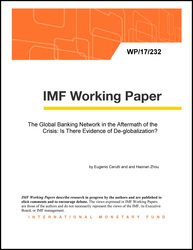
The Global Banking Network in the Aftermath of the Crisis: Is There Evidence of De-globalization?
Post-crisis dynamics show a shrinkage in the overall amount of crossborder bank lending,
which has been interpreted in the literature as a retreat in financial globalization. In this
paper, we argue that aggregate figures are not sufficient to support such a claim in terms of
the overall structure of the global banking network. Based on a systematic approach to
measuring, mapping and analyzing financial interconnectedness among countries using
network theory, we show that, despite the decline in aggregate lending volumes, the structure
of the network has developed increased connections in some dimensions. Some parts of the
network are currently more interlinked regionally than before the crisis, and less dependent
on major global lenders. In this context, at a more disaggregate level, we document the
characteristics of the increasing regionalization of lending flows, the different evolution of
linkages through bank affiliates and direct cross-border claims, as well as the shift in the
importance of key borrower and lender nodes. These changes in the banking network have
important insights in terms of policy implications since they indicate that the global banking
network has evolved, but it has not undergone a generalized retrenchment in financial
linkages.
Publication date: November 2017
ISBN: 9781484324868
$18.00
Add to Cart by clicking price of the language and format you'd like to purchase
Available Languages and Formats
| English |
Prices in red indicate formats that are not yet available but are forthcoming.
Topics covered in this book
This title contains information about the following subjects.
Click on a subject if you would like to see other titles with the same subjects.
Cross-border Lending , Banking Network , Financial Interconnectedness , International Lending and Debt Problems , Financial Aspects of Economic Integration , Other
Summary
Copyright © 2010 - 2024
Powered by:
AIDC



